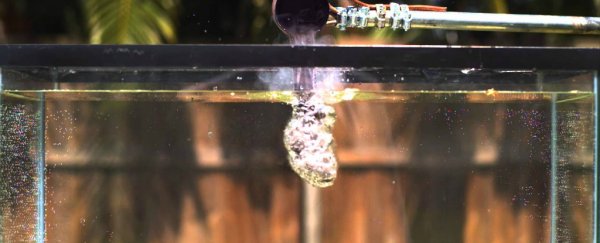
**Update: The full video is now ready!** There's no shortage of weird and wonderful reactions out there. But sometimes the way two seemingly innocuous substances interact can still take you by surprise, like the dramatic explosion than happens when TheBackyardScientist pours molten salt into water. Take one look at his face after he blows up his fish tank, and it's pretty clear that this is definitely not what he was expecting to happen.
Keep watching, and you can see the whole reaction slowed down to a glorious 5,000 frames per second. And, in case we need to remind you, please don't try this at home - TheBackyardScientist is lucky to get away unharmed with those bare legs as it is.
So from a scientific point of view, what's going on here, because salt + water sounds like an innocent enough combination, right? The short answer to that question is, we're still not entirely sure, but there are some pretty cool possible explanations.
In fact, TheBackyardScientist has released this teaser in the hopes of figuring out what's going on, and he's taken it to Reddit to get some answers.
He initially tried the experiment after seeing something similar happen in this What We Made video, which shows molten salt triggering small explosions in water.
"I had to try this for myself. I was extremely curious why it exploded," he explains on Reddit. Why is it such a surprise? Because, physically speaking, the salt water should never come in contact with the water, thanks to something called the Leidenfrost effect.
This effect occurs when a liquid comes into contact with a substance significantly hotter than its boiling point and forms an insulating layer of vapour. This happens with molten aluminium, which TheBackyardScientist regularly pours into water (and watermelons) to make all kinds of pretty formations without explosions.
Some metals, like tin, do cause little explosions, but that's because their melting point is so low (231.9 degrees Celsius). But salt melts at around 800 degrees Celsius - almost 200 degrees higher than aluminium - which means that it should easily be hot enough to trigger the Leidenfrost effect. So why is it still reacting with the water?
As usual, the Reddit community has come through with some pretty well-educated guesses, with a nice explanation of the cause of the explosion from midnight-cheeseater:
"In the slow motion shots, you can see that the molten salt instantly forms a layer of steam around itself when poured into the water. This insulates the bulk of the salt from cooling down via the Leidenfrost effect.
The steam layer rapidly becomes superheated, causing a large and almost instant increase in pressure. At the surface of the water, this high pressure steam can easily escape. But as the blob of molten salt sinks deeper, the pressurised steam is confined by the water around it. This causes the pressure to rise even further, even quicker, until it overcomes the water pressure holding it back and you get an explosion."
That makes sense, but the remaining question is why this doesn't happen with aluminium, which has a lower melting point. The jury is still out on that one, but for now, the leading explanation is that it has something to do with salt's viscosity and surface areas as it interacts with the steam.
Update: The full video is now ready, so see TheBackyardScientist's explanation below!

**Update: It appears TheBackyardScientist has taken the video down for now - hopefully with a longer episode on its way soon to answer all our questions. Watch this space, we'll get it up as soon as the footage is released.**
